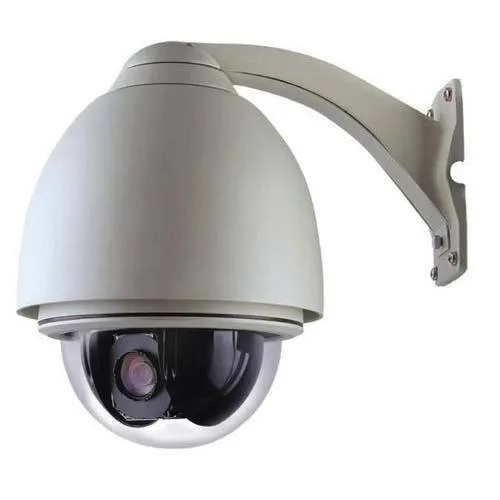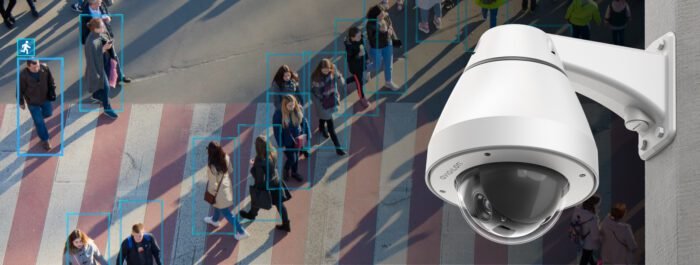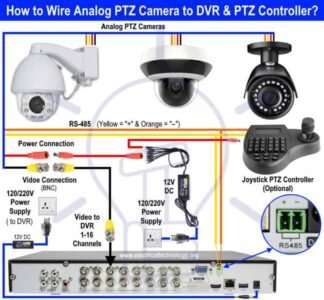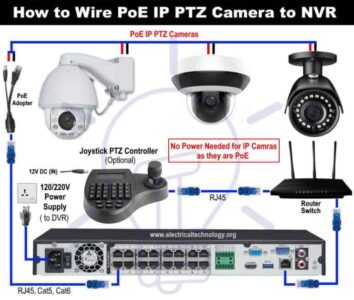How to Guides, Security
How to Connect Analog and IP PTZ Camera with DVR and NVR
How to Connect Analog and IP PTZ Camera with DVR and NVR
What is a PTZ Camera?
PTZ Camera is an abbreviation for “PAN-TILT-ZOOM Camera.” It is a specially designed security camera with numerous features and functions. A pan-tilt-zoom (PTZ) camera can change and control the movement direction as well as zoom in and out automatically by DVR/NVR systems or manually by joystick PTZ controller.
A PTZ camera in a modern DVR or NVR security system can be controlled via the internet from a computer or mobile device. This allows the movement of a PTZ camera to be monitored and controlled from anywhere with an active internet connection.
In PTZ cameras, a special type of motor known as a “stepper motor” is used for movement control and operates in periodic steps. These motors are used to move the camera “Left,” “Right,” “Up,” and “Down.”
The latest IP PTZ camera can pan (horizontally) and tilt (vertically) up to “360°” while having a zoom range of “112°” and an optical zoom range of 3x to 30x without sacrificing image quality.
How PTZ Camera Works?
Let’s take a look at how a PTZ camera pans, tilts, and zooms.
- PAN: A PTZ camera can move horizontally (left and right) and circularly up to 360 degrees to cover a large area.
- TILT: The most recent models of cameras can tilt up to 180 degrees up and down and are capable of monitoring a large vertical area.
- ZOOM: It is not recommended to zoom the camera too far in order to maintain image quality, even though it can zoom in and out up to 30x by changing the lens focal length.
Types of PTZ Cameras
There are 4 basic types of PTZ cameras as below:
- Analog PTZ Cameras
- IP PTZ Cameras
- HD-CVI Cameras
- ePTZ or VPTZ Cameras
Let’s take a quick look at the various PTZ camera technologies.
Analog PTZ Cameras
Analog PTZ cameras have a range of up to 300 meters (1000 feet), but due to high voltage drop, they can only be powered up to 45 meters (150 feet) for video and RS-485. The voltage drop can be reduced by providing power to the cameras separately or by providing high amperes power supply (e.g. after 45m (150ft), a 1 ampere camera can be powered up with 3 amperes (Note: Although this works perfectly, it is not a recommended method to do so and exceed the 45 meter (150 feet) limit).
Analog cameras send video signals to DVRs via BNC cables (Digital Video Recorder). Separate power cables are also required to power the cameras. To control the movement of the camera, an RS-485 cable can be used to connect the analog camera to the DVR or PTZ controller.
IP PTZ Cameras
Due to slandered networking limitations, IP PTZ Cameras have a range of up to 100 meters (300 feet). Because power and video signals can be transmitted over a single PoE (power over internet) RJ45, Cat5, or Cat6e cable, the length cannot be extended without the use of additional devices. A PoE injector can be used to extend the length limit to 100 meters for this purpose (300 feet).
The IP camera can be connected directly to the NVR (Network Video Recorder) via PoE cable from the camera and RJ45, Cat5 or Cat6e cables. As a result, there is no need to power the cameras with a separate power supply because cat5 or cat6e cables can provide power while also transmitting video signals from the camera to the NVR. An optional PTZ controller can be used to manually control movement by connecting it to the DVR and a router switch via RJ45 cable.
HD-CVI Cameras
HD-CVI is an abbreviation for High Definition Composite Video Interface. The latest HD-CVI technology in CCTV cameras uses a single coaxial cable to transmit control, audio, and HD video signals up to 1920 x 1080 “2 Megapixel” (1080p video resolution) between transmitter and receiver. The resolution rate is 450% higher than that of analog cameras.
ePTZ or VPTZ Cameras
ePTZ or VPTZ (also known as Virtual Pan-Tilt-Zoom) cameras digitally pan, tilt, and zoom an image into portions without physical camera movement because ePTZ refers to a software function rather than hardware. They can cover a large area with a 360-degree rotation but significantly reduce image quality with digital zoom and zoom in because it enlarges the pixel.
VPTZ is also known as “Digital Zoom” because the camera does not move physically but the navigation and scaling can be controlled digitally where ePTZ or VPTZ are connected to the DVR or NVR to analyze the recording later when needed.
Let’s take a look at how to connect analog and IP PTZ cameras to the NVR / DVR and PTZ controller, as shown below.
Diagram of Analog PTZ Camera Connection to DVR
The diagram below shows how to connect an analog PTZ camera to a DVR and a joystick PTZ controller. BNC cables are used to transmit video signals, whereas RS-485 cables are used to control camera movement and rotation by connecting it to a joystick PTZ controller or DVR system. Remember that the CCTV cameras require a separate 12V DC power supply.
The yellow in RJ-45 cable represents the positive “+,” while the orange represents the negative “-.” In other configurations, Red is used to represent 485+ and Black is used to represent 485-, or Blue and Green can be used to represent positive and negative values, respectively.
Wiring Diagram for a PoE IP PTZ Camera to an NVR
The wiring diagram below shows how to connect a PoE IP PTZ camera to the NVR and joystick PTZ controller. There is no need to power up the camera with an additional DC supply source in this wiring connection because it is an IP PoE (power over Ethernet) system. Simply connect the IP camera pigtails to the PoE adopter, which is then connected to the NVR via RJ45, Cat5 or Cat6 cable.
Connect the optional PTZ controller to the router switch via RJ45 cable, which is then connected to the NVR via another RJ-45 connector.
Browse our collection of PTZ Cameras for sale in Kenya and make a choice of a suitable camera for your needs. You can also contact us shall you need CCTV installation services in Kenya for your home or business.
You can also check:
A Guide to CCTV and Intruder Alarms for Business in Kenya
17 Things to Consider Before Buying a CCTV Camera in Kenya





Comments are closed.